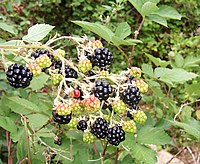
Photo from wikipedia
Abstract In the present contribution, the effects of different contaminants of emerging concerns (CECs), including parabens, drugs, and polycyclic aromatic hydrocarbons (PAHs) on antioxidant activity of Lactuca sativa L. in… Click to show full abstract
Abstract In the present contribution, the effects of different contaminants of emerging concerns (CECs), including parabens, drugs, and polycyclic aromatic hydrocarbons (PAHs) on antioxidant activity of Lactuca sativa L. in different concentration levels (10–500 µg L−1) were evaluated using ultraviolet–visible (UV–Vis) spectrophotometry combined with chemometric techniques. The extracts of lettuce samples were investigated for the antioxidant activity (AA), total phenolic content (TPC), and total flavonoid content (TFC) after 39 days of planting and 14 days of exposure. Then, the spectroscopic data were arranged in two different data matrices, including (i) the control lettuce samples and PAHs exposed samples and (ii) control samples and parabens/drugs exposed samples. The data were then analyzed using unsupervised pattern recognition techniques of principal component analysis (PCA) and hierarchical cluster analysis (HCA) and supervised pattern recognition method of partial least squares-discriminant analysis (PLS-DA). The PCA and HCA results suggested that samples belong to different groups. Then, the PLS-DA model was applied to indicate discrimination between types of organic pollutants. The PLS-DA results showed proper discrimination between control and exposed samples with an accuracy > 90%. It is concluded that the TFC, AA, and TPC values in controls were increased under the specific exposure circumstances.
Journal Title: Microchemical Journal
Year Published: 2021
Link to full text (if available)
Share on Social Media: Sign Up to like & get
recommendations!